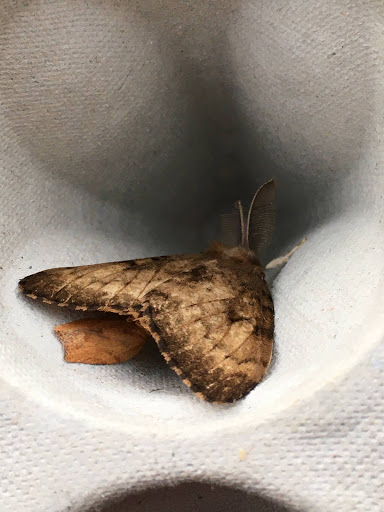After a week of inactivity, the moth trap was back in action last night at last. And, goodness, were the eggboxes busy. I had a feeling that they would be, as the evening was lovely and warm when I lit the lamp after my Zoom yoga on the lawn. (I wonder if this attracts the moths, if only out of curiosity. During the periods when I was lying on my back, a pose I enjoy, I saw first a couple of hawking dragonflies and at the end, as dusk drew on, plenty of bats).
I took these photos of the light too, immediately after switching it on, not realising at the time that one showed a dark sky while the other, taken a couple of seconds later if that, has a shining light. Spooky. Or maybe a 'plane.
Most of the 350 or more arrivals were standard guests: large numbers of the various Yellow Underwings; lots of faded Green Carpets, full many a Burnished Brass. But there were two who were both new to my records and also interesting: Gypsy moths, which strike terror into the hearts of tree owners because of the devastation which can be wrought by their caterpillars when they congregate en masse.
I don't need telling about caterpillars during my current war to the death with 'Cabbage White' ones, so I've dutifully reported my guests to Forest Alert. This needs doing, I think, because the Gypsy moth is on a real roll. It was reckoned extinct in the UK by 1909 when the last endemic colony in the fenlands of East Anglia disappeared. But now the moth is making tremendous headway from continental Europe. I first saw one in my grandchildren's garden (or strictly, on their dining room windowsill) exactly a year ago and recently two other members of the Upper Thames Moths blog have recorded them in their traps.
Although a potential pest, the moths are very attractive and famous for their front view pose, with those beady eyes and great big, bushy antennae. It had to head this post. I thought that I had the just the one moth but then a final eggbox revealed another, tucking itself snugly into one of the cones and sheltering a little tortrix micro moth in the process:







3 comments:
Well. A lot to say.
It was my birthday yesterday.
That is Gold Spot. Up here we get Lempkes because of the Moors here.
On Gypsy moths. The UK had its own form of Gypsy Moth that fed on Bramble and wasn't destructive. That was made extinct because of the Victorian era. Then, recently the European Form of the moth arrived which is destructive in this country because it doesn't fit into our ecosystem yet on the continent it does but isn't destructive, so as usual humans fault.
Thanks
E
Gypsy Moths are now really common in London- see the males whizzing around a lot in the last few weeks.
Belated happy birthday, Edward Hope the moths put on a good show.
What an interesting moth the Gypsy is. Maybe we can tempt the new lot to try bramble. It is the blackberrying season after all.
all warm wishes both
M
Post a Comment